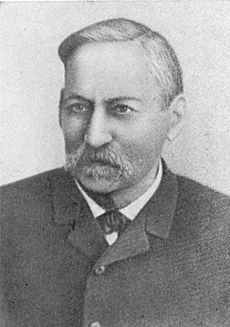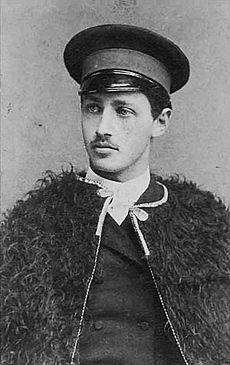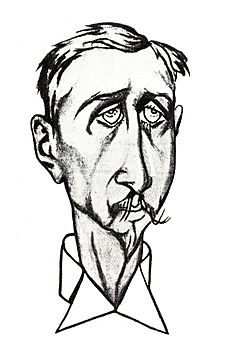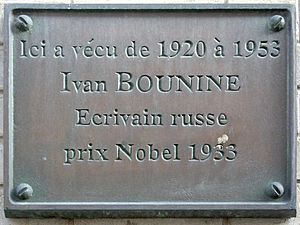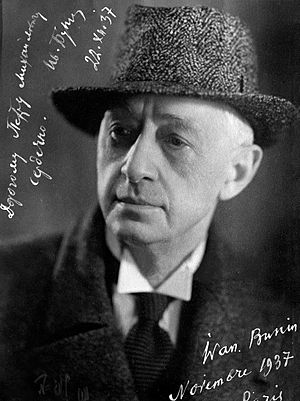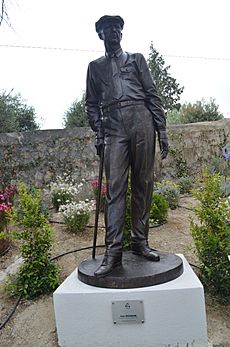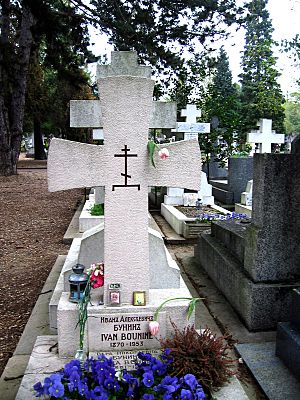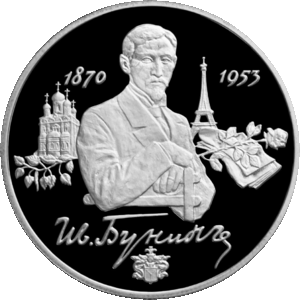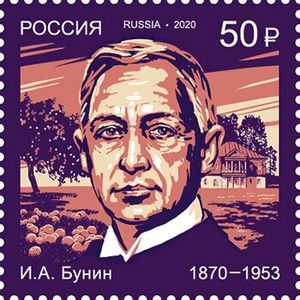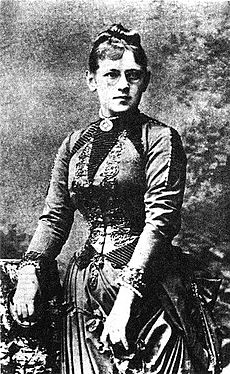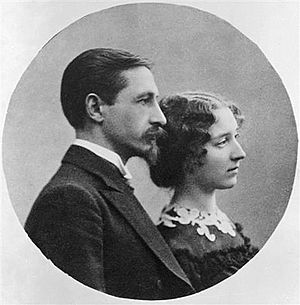Ivan Bunin facts for kids
Quick facts for kids
Ivan Bunin
|
|
|---|---|
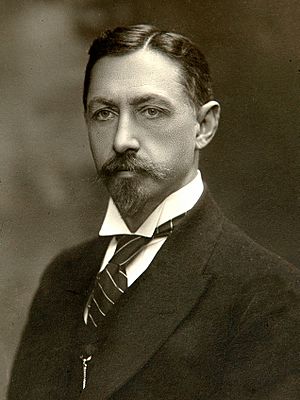
Bunin c. 1890
|
|
| Native name |
Ива́н Алексе́евич Бу́нин
|
| Born | 22 October 1870 Voronezh, Russian Empire |
| Died | 8 November 1953 (aged 83) Paris, France |
| Nationality | Russian |
| Genre | fiction, poetry, memoirs, criticism, translations |
| Notable works | The Village (1910) "The Gentleman from San Francisco" (1915) The Life of Arseniev (1927–1939) Dark Avenues (1938–1946) |
| Notable awards | Nobel Prize in Literature 1933 Pushkin Prize 1903, 1909 |
| Signature | |
 |
|
Ivan Alekseyevich Bunin (born October 22, 1870 – died November 8, 1953) was a famous Russian writer. He was the first Russian to win the Nobel Prize in Literature. Bunin was known for his beautiful and precise writing style in both stories and poems. His work is often called "Bunin brocade" because it's so rich and detailed.
He is especially remembered for his short novels like The Village (1910) and Dry Valley (1912). His life story, The Life of Arseniev (1933, 1939), and the short story collection Dark Avenues (1946) are also very famous. Many people, including other writers, saw him as a true follower of the realistic writing style of Tolstoy and Chekhov.
Contents
Discovering Ivan Bunin's Life
Early Years and Family
Ivan Bunin was born on his family's estate in the Voronezh area of Russia. He was the youngest of three sons. His parents were Aleksey Nikolayevich Bunin and Lyudmila Aleksandrovna Bunina. He also had two younger sisters.
Bunin was proud that famous poets like Anna Bunina and Vasily Zhukovsky were part of his family history.
Ivan's early childhood was happy. He grew up in the countryside, surrounded by loving people. His father, Aleksey, was a strong and lively man who loved to gamble. His mother, Lyudmila, was gentle and introduced Ivan to Russian folk tales.
Ivan was very sensitive to nature. He later wrote that his childhood in the quiet fields and snowy landscapes was "full of melancholic poetry."
His first teacher was a man named Romashkov, who told many interesting stories. Later, his older brother Yuly taught him about psychology and philosophy. Yuly encouraged Ivan to read classic Russian books and to write his own stories. Yuly was Ivan's close friend and mentor for many years.
By the late 1870s, the Bunin family lost most of their money because of his father's gambling. In 1881, Ivan went to a public school in Yelets, but he had to leave in 1886 because his family couldn't afford it.
Starting a Writing Career
In May 1887, Bunin's first poem, "Village Paupers," was published in a magazine in Saint Petersburg. In 1891, his first short story, "Country Sketch," appeared in a journal.
In 1889, Bunin moved to Kharkiv to work as a government clerk and later as an assistant editor for a local newspaper. This allowed him to publish his own stories and poems. He then moved to Oryol to work for another newspaper, where he met Varvara Pashchenko and fell in love.
Ivan Bunin's first book of poems, Poems. 1887–1891, was published in 1891. His early writings began to appear in bigger magazines in Saint Petersburg.
In 1894, Bunin traveled across Ukraine. He later wrote that he "fell in love with Malorossiya (Little Russia), its villages and steppes," and enjoyed meeting people and listening to Ukrainian songs.
In 1895, Bunin visited the Russian capital for the first time. There, he met famous writers like Anton Chekhov, Maxim Gorky, and Leo Tolstoy. He became good friends with Chekhov. Bunin admired Tolstoy's writing and even tried to live like him for a while.
In 1897, his first collection of short stories, To the Edge of the World and Other Stories, was released. A year later came In the Open Air (1898), his second book of poems. In 1898, he moved to Odessa. He also joined a literary group in Moscow where he was known for supporting classic Russian literature.
Literary Success and Travels (1900-1909)
Bunin published Poems and Stories (1900) and Flowers of the Field (1901). His third poetry book, Falling Leaves (1901), was highly praised by critics and other writers. They admired its "rare subtlety" and clear, wholesome style. Maxim Gorky called Bunin "the first poet of our times." For Falling Leaves and his translation of Henry Wadsworth Longfellow's The Song of Hiawatha, Bunin won his first Pushkin Prize.
Around this time, Bunin started writing more prose (stories) than poetry. His prose became richer and more precise. He believed that stories could have a poetic rhythm while still being prose.
In 1900, his novella Antonov Apples was published. It is now considered one of his masterpieces. Other popular novellas from this time included On the Farm and To the Edge of the World. These stories showed his careful use of language and detailed descriptions of nature.
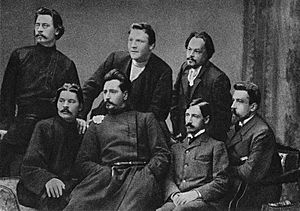
Bunin traveled a lot in the early 1900s. He continued to visit Chekhov and his family. The social unrest of 1905, known as the First Russian Revolution, found Bunin in Yalta. He saw the events as a desire for chaos rather than true progress.
In November 1906, Bunin began a relationship with Vera Muromtseva. They left Russia in April 1907 for a long trip through Egypt and Palestine. This journey inspired his collection Bird's Shadow (1907–1911). Critics began to notice the vibrant and dynamic quality of his writing. Bunin felt that traveling helped him see Russian life more clearly.
In October 1909, Bunin received his second Pushkin Prize. He was also elected a member of the Russian Academy of Sciences that same year.
Major Works and Revolution (1910-1920)
In 1910, Bunin published The Village, a very honest and sometimes harsh look at Russian country life. This book caused a lot of discussion and made him famous. Maxim Gorky called Bunin "the best Russian writer of the day" because of its realism.
Bunin said he was moving away from earlier political ideas and was closer to social democrats, but he still avoided political parties. He believed the working class was powerful but lacked organization. He also felt there was a sad gap between educated people and the common masses in Russia.
In December 1910, Bunin and Muromtseva traveled again, visiting the Middle East and Ceylon. This trip led to stories like "Brothers." In 1912, his novel Dry Valley was published. It was another semi-autobiographical story about the difficult conditions in Russian rural areas.
Bunin and Muromtseva spent three winters (1912–1914) with Gorky on the island of Capri. During World War I, Bunin was worried about Russia's future but continued to write. In 1915, he published The Chalice of Life, which was highly praised. The same year, his most famous short story, The Gentleman from San Francisco, was published and later translated into English. Bunin also translated works by other poets like Lord Byron and Tennyson.
Bunin stayed away from literary arguments of his time. He said he didn't belong to any specific literary group. By 1916, he felt very pessimistic and almost stopped writing, saddened by the millions of deaths in the war.
In May 1917, the Bunins moved to a family estate. In October, they returned to Moscow, where life was dangerous due to the Russian Revolution. Bunin strongly disliked the Bolsheviks (the group that took power). In April 1917, he broke off his friendship with Gorky because Gorky supported the revolution. On January 26, 1920, Bunin and his wife left Russia on a French ship from Odessa, eventually arriving in Constantinople.
Life in Exile (Emigration)
On March 28, 1920, after short stays in other cities, Bunin and Muromtseva arrived in Paris, France. They spent their time between Paris and rented homes near Grasse in the south of France. Bunin hated Bolshevism, but he didn't want other countries to interfere in Russia. He believed Russians should solve their own problems.
Despite the challenges of being in a new country, Bunin slowly started writing again. His first book published in France, Scream, contained stories he had written earlier.
In France, Bunin published many of his older works and new stories. He often felt that he belonged to "the old world" of Russia, where his inspiration had been strongest. However, his new stories showed great artistic growth. Works like Mitya's Love (1924), Sunstroke (1925), and especially The Life of Arseniev (written 1927–1929) were highly praised.
From 1925 to 1926, Bunin's diary from 1918–1920, called Cursed Days, began to appear in a Paris newspaper. This diary was one of the few anti-Bolshevik accounts from the time of the Russian Revolution.
In the 1920s and 1930s, Bunin was seen as a leading voice for Russians living outside their homeland. He was the first Russian to win the Nobel Prize for Literature in 1933. The award was given "for following through and developing with chastity and artfulness the traditions of Russian classic prose." Bunin thanked the Swedish Academy for honoring a writer in exile.
After winning the Nobel Prize, Bunin became very famous in France. He donated a large part of his prize money to a charity fund for writers. He traveled throughout Europe, and his journeys were often reported in Russian newspapers published abroad.
In 1934–1936, his Complete Bunin in 11 volumes was published in Berlin. In 1938, Bunin began writing a famous series of nostalgic stories. The first part, Dark Avenues, came out in New York in 1943. These stories had a deeper, more thoughtful tone, perhaps as a way to escape the difficult reality of the Nazi occupation.
World War II Years
When World War II started, Bunin's friends in New York offered to help him move to the US. But he and his wife chose to stay in Grasse, France, living high in the mountains at Villa Jeanette. They spent the war years there with a few other young writers.
Life was hard during the war. They grew their own vegetables to survive. A journalist who visited in 1942 described Bunin as looking thin and tired. But Bunin found peace in this isolation and refused to move to Paris. He complained about the cold, which made it hard to write. His wife, Vera, remembered that writing continuously was the only way they could cope with hunger, cold, and fear.
Ivan Bunin strongly disliked Adolf Hitler and Benito Mussolini. He even risked his life by sheltering people in danger, including Jewish people, in his home after the Germans occupied Vichy. He also invited Soviet war prisoners to his home, even though German headquarters were very close by.
Bunin continued to write during the occupation but didn't publish anything. He turned down offers to write for newspapers in Switzerland. On August 24, 1944, he wrote that the Germans had left Grasse, and the Americans had arrived, which brought great relief.
Final Years
In May 1945, the Bunins returned to Paris. Bunin looked lively, as if the war years hadn't affected him. He was very happy about France's liberation.
Bunin even attended a Soviet Russian Theatre show in Paris. When a young Red Army colonel recognized him, Bunin stood up and said he had "the even higher honor of sitting next to an officer of the great Red Army!"
In the autumn of 1945, Bunin's 75th birthday was widely celebrated by the Russian community in Paris. He started talking with Soviet officials and journalists, and there were rumors that his complete works might be published in the USSR.
In the late 1940s, Bunin considered returning to the Soviet Union, especially because he was interested in new Soviet literature and faced financial difficulties. However, after his Memoirs (1950) were published, which criticized Soviet culture, the idea of his return ended. He wrote that he was born "too late" and had witnessed too many difficult events like wars and revolutions.
After 1948, Bunin's health got worse. He focused on writing his memoirs and a book about Anton Chekhov. His wife and a friend helped him finish the Chekhov book after his death. In 1951, Bunin became the first honorary member of International PEN, representing writers in exile. His last years were marked by sadness and illness, including asthma and pneumonia.
On May 2, 1953, Bunin wrote his last diary entry, reflecting on his approaching death.
Ivan Alekseyevich Bunin passed away in Paris on November 8, 1953, from heart failure. He was buried in the Sainte-Geneviève-des-Bois Russian Cemetery.
In the 1950s, Bunin became the first Russian writer in exile to have his books officially published in the USSR. His complete works came out in Moscow in 1965. However, some of his more controversial books, like Cursed Days, were not allowed in the Soviet Union until the late 1980s.
Bunin's Lasting Impact
Ivan Bunin is remembered as the first Russian writer to win the Nobel Prize for Literature. While The Life of Arseniev was a key reason for the award, his influence goes much further. He is seen as a master of short stories, known for his unique style that blended classic traditions with new artistic expression.
Bunin's early stories often explored the beauty of nature and how it contrasted with human flaws. Anton Chekhov praised his early works, and Maxim Gorky always considered Bunin one of Russia's greatest writers.
As a poet, Bunin was influenced by earlier Russian poets. His early poems often focused on the decline of the old Russian nobility. Later, his style became more thoughtful and philosophical. He disliked modern art movements that he felt were too showy.
Bunin was known for his deep love of nature. Poet Alexander Blok noted that Bunin's love for nature made his writing rich and detailed. Bunin won the Pushkin Prize three times for his poetry, especially for Falling Leaves (1901). Even Vladimir Nabokov, who sometimes criticized Bunin's stories, admired his poetry.
Bunin's novel The Village (1910) was very important. It showed Russian village life in a raw, honest way, changing how Russian peasants were portrayed in literature. He continued the realistic traditions of Russian literature when they were being challenged by new styles.
Dry Valley was another important step for Bunin. It explored the "Russian soul" and the unique features of the Slavic mind. Gorky called it "one of the greatest books of Russian horror."
Bunin's travel writings, like Bird's Shadow (1907–1911), were also innovative. Critics noted his amazing ability to understand and describe different cultures, both ancient and modern.
Bunin was interested in myths and folklore from around the world, as well as Russian traditions. He disliked writers who he felt used fake or overly decorated styles. He admired Tolstoy for his honesty and lack of exaggeration.
Some people called Bunin a "cold" writer, but his philosophical poems showed deep passion. His wife, Vera, said that while he might have seemed distant, he was capable of great tenderness.
Many of Bunin's best stories, like "The Gentleman from San Francisco" and "Brothers", had a strong philosophical side. He was influenced by the ideas of Socrates, believing in the value of each person.
In his views on Russia's history, Bunin initially admired the ancient Rus period. Later, his view became more negative. He believed the Russian people had two sides: one from ancient Rus and another with a "frightening instability."
Even though his works were mostly banned in the Soviet Union until the mid-1950s, Bunin greatly influenced many Soviet writers. His books have been translated into many languages, and leading writers worldwide have praised his talent. Writers like Romain Rolland, Thomas Mann, and André Gide admired his artistic genius and his ability to express human feelings.
On October 22, 2020, Google celebrated his 150th birthday with a special Google Doodle.
Ivan Bunin's Personal Life
Bunin's first love was Varvara Pashchenko. He met her in 1889 and they worked together in Oryol. Their relationship was difficult because her father didn't approve due to Bunin's lack of money. Varvara was also unsure about marriage. They moved in together, but their relationship ended in 1894 when she married one of Bunin's friends. Bunin felt hurt by this. Some believe Varvara inspired the character Lika in his novel The Life of Arseniev.
In the summer of 1898, Bunin met Anna Tsakni, the 18-year-old daughter of a newspaper publisher in Odessa. They married on September 23, 1898, but their marriage quickly became troubled. They separated in March 1900, and Anna gave birth to their son, Nikolai, later that year. Bunin saw very little of his son, who sadly died in 1905 from illness.
Ivan Bunin's second wife was Vera Muromtseva (1881–1961). They met in November 1906 and became inseparable. They officially married in 1922 after Bunin was able to legally divorce Anna Tsakni. Years later, Vera Muromtseva-Bunina wrote a book about their life together called Life of Bunin.
See also
 In Spanish: Iván Bunin para niños
In Spanish: Iván Bunin para niños
- List of poems by Ivan Bunin
- List of short stories by Ivan Bunin


